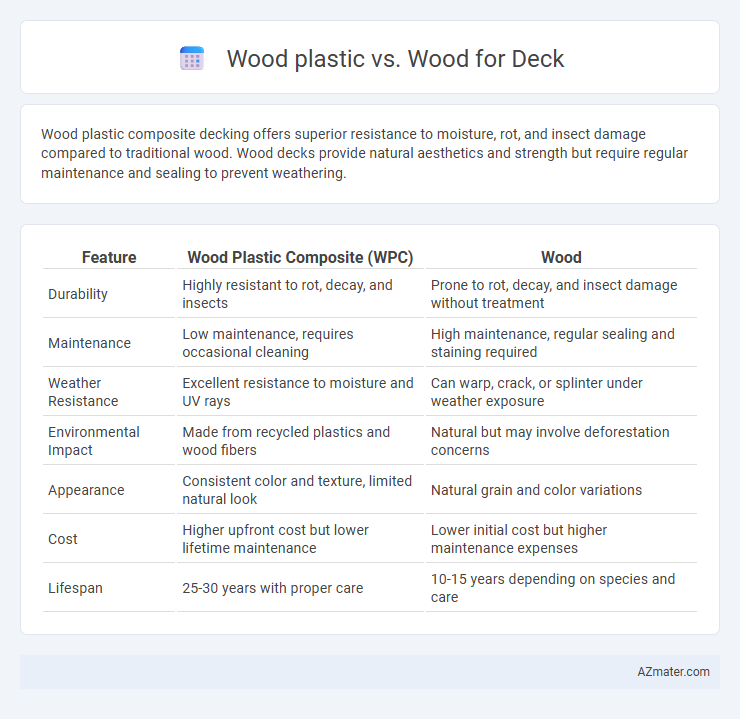Wood plastic composite decking offers superior resistance to moisture, rot, and insect damage compared to traditional wood. Wood decks provide natural aesthetics and strength but require regular maintenance and sealing to prevent weathering.
Table of Comparison
| Feature | Wood Plastic Composite (WPC) | Wood |
|---|---|---|
| Durability | Highly resistant to rot, decay, and insects | Prone to rot, decay, and insect damage without treatment |
| Maintenance | Low maintenance, requires occasional cleaning | High maintenance, regular sealing and staining required |
| Weather Resistance | Excellent resistance to moisture and UV rays | Can warp, crack, or splinter under weather exposure |
| Environmental Impact | Made from recycled plastics and wood fibers | Natural but may involve deforestation concerns |
| Appearance | Consistent color and texture, limited natural look | Natural grain and color variations |
| Cost | Higher upfront cost but lower lifetime maintenance | Lower initial cost but higher maintenance expenses |
| Lifespan | 25-30 years with proper care | 10-15 years depending on species and care |
Introduction to Decking Materials
Wood plastic composite (WPC) decking offers enhanced durability and low maintenance compared to traditional wood, making it resistant to rot, insects, and weathering. Natural wood decking, such as cedar or redwood, provides authentic aesthetics and natural texture but requires regular sealing and upkeep to prevent decay. Choosing between wood plastic and wood decking depends on factors like budget, desired lifespan, and environmental considerations.
What is Wood Plastic Composite?
Wood plastic composite (WPC) is a material made by combining wood fibers or sawdust with thermoplastic polymers, such as polyethylene, polypropylene, or polyvinyl chloride, resulting in a durable and low-maintenance decking option. WPC offers enhanced resistance to rot, decay, and insect damage compared to traditional wood, while mimicking wood's natural appearance. Its composite structure also provides improved dimensional stability, reducing issues like warping and splintering commonly seen in wooden decks.
Traditional Wood: Types and Features
Traditional wood for decks includes species like cedar, redwood, and pressure-treated pine, each offering distinct durability and aesthetic qualities. Cedar and redwood naturally resist decay and insects, providing a rich, warm appearance, while pressure-treated pine is chemically treated for enhanced longevity and cost-effectiveness. These woods require regular maintenance such as sealing and staining to preserve their structural integrity and appearance over time.
Durability: Wood Plastic vs Wood
Wood plastic composite decking offers superior durability compared to traditional wood, resisting rot, splintering, and insect damage effectively. Unlike wood, which requires regular sealing and maintenance to prevent warping and decay, wood plastic composites maintain their structural integrity and appearance with minimal upkeep. This resilience makes wood plastic an ideal choice for long-term decking solutions in varying weather conditions.
Maintenance Requirements Compared
Wood plastic composites (WPC) require significantly less maintenance compared to natural wood, as they resist rot, insects, and splintering without the need for regular sealing or staining. Wood decks demand annual upkeep, including sanding, staining, and sealing to protect against moisture and UV damage, which can lead to warping and cracking. Choosing WPC reduces time and cost associated with maintenance while providing durable, long-lasting performance in outdoor environments.
Environmental Impact and Sustainability
Wood plastic composites (WPC) for decking often incorporate recycled plastics and wood fibers, reducing reliance on virgin materials and lowering landfill waste. Traditional wood decks, especially those made from sustainably harvested or FSC-certified lumber, offer natural biodegradability but may contribute to deforestation if sourced irresponsibly. WPC decks generally require less maintenance and have longer lifespans, which can reduce environmental impact over time compared to frequently replaced natural wood decks.
Cost Comparison: Upfront and Long-Term
Wood plastic composite decking generally has a higher upfront cost, ranging from $30 to $45 per square foot, compared to natural wood decking which typically costs between $15 and $30 per square foot. Long-term expenses favor wood plastic due to its lower maintenance requirements and resistance to rot, insects, and warping, reducing costs for sealing, staining, and repairs over time. Natural wood decking demands frequent upkeep and potential replacements, increasing lifetime expenditure despite its initial affordability.
Aesthetic Differences: Looks and Feel
Wood plastic composite decking offers a uniform appearance with consistent colors and textures, mimicking natural wood grain while resisting fading, splintering, and warping. Natural wood decking provides a rich, authentic aesthetic with unique grain patterns and warm tones that develop character over time but requires regular maintenance to preserve its beauty. The tactile experience differs as wood feels warmer and more organic underfoot, whereas wood plastic composite tends to have a smoother, cooler surface.
Safety and Slip Resistance
Wood plastic composites (WPC) offer enhanced slip resistance compared to natural wood due to their textured surface and embedded materials that provide better grip even when wet. Natural wood can become slippery as it weathers and accumulates algae or moisture, increasing the risk of falls without regular maintenance. WPC decking materials are engineered for safety, often featuring non-slip additives and consistent surface texture that reduce slip hazards in outdoor environments.
Choosing the Best Decking Material
Wood-plastic composite decking offers superior durability, low maintenance, and resistance to rot and insects compared to traditional wood, making it ideal for long-term outdoor use. Natural wood provides a classic aesthetic and can be more cost-effective upfront but requires regular staining and sealing to prevent weather damage. Choosing the best decking material depends on balancing budget, desired longevity, maintenance willingness, and aesthetic preferences.

Infographic: Wood plastic vs Wood for Deck
 azmater.com
azmater.com